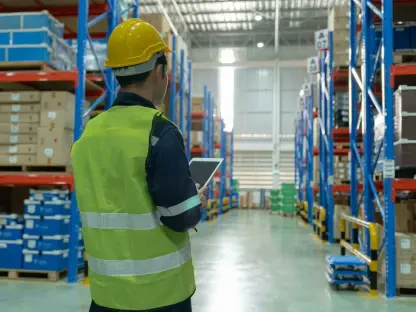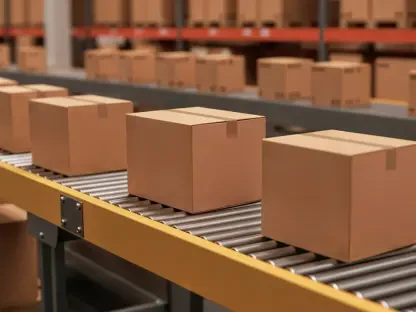In an era where supply chain transparency is no longer a luxury but a necessity, blockchain technology emerges as a transformative force in package labeling, tackling persistent issues of trust and efficiency. With global trade networks growing increasingly complex, businesses face mounting pressure to ensure accurate tracking, regulatory compliance, and consumer satisfaction, making blockchain a compelling solution by providing a secure, decentralized framework that could redefine how products are traced from origin to destination. This review delves into the capabilities of blockchain in supply chain labeling, exploring its core features, real-world applications, and the challenges that lie ahead, while offering a glimpse into its potential to revolutionize logistics.
Understanding Blockchain in Supply Chain Labeling
Blockchain technology, at its core, is a distributed ledger system that records transactions across multiple computers in a way that ensures data cannot be altered retroactively. This decentralization eliminates the need for a central authority, fostering trust among stakeholders through transparency and cryptographic security. In the context of supply chain management, blockchain addresses critical pain points such as fraud, errors, and inefficiencies by creating a reliable digital trail for every product movement.
The relevance of blockchain in labeling becomes evident when considering the modern challenges of global supply chains. Issues like counterfeiting, regulatory non-compliance, and lack of visibility have long plagued industries, often resulting in costly recalls or reputational damage. Blockchain positions itself as a pivotal innovation by enabling tamper-proof records that enhance accountability across vendors, manufacturers, and logistics providers.
This technology also fits into the broader landscape of digital transformation in logistics, complementing tools like IoT and AI. As supply chains evolve to meet consumer demands for speed and transparency, blockchain stands out for its ability to ensure data integrity in labeling processes. Its emergence marks a shift toward more resilient and collaborative systems, setting the stage for deeper exploration of its specific benefits.
Core Features of Blockchain for Labeling
Secure and Tamper-Proof Data Records
One of blockchain’s standout attributes is its capacity to create unalterable digital records of product journeys through the supply chain. Each transaction or update to a product’s label—whether a change in location or status—is timestamped and linked to previous entries, forming an immutable chain. This feature ensures data integrity, making it nearly impossible for malicious actors to manipulate information without detection.
Such security proves invaluable in high-stakes industries like food and pharmaceuticals, where accurate chain-of-custody tracking is critical. For instance, during a product recall, blockchain allows companies to swiftly identify affected batches, minimizing risks to consumer safety and reducing financial losses. The ability to trust the authenticity of labeling data also strengthens regulatory compliance, a growing concern in global markets.
Beyond safety, tamper-proof records build confidence among consumers who increasingly demand proof of product origins and ethical practices. Blockchain’s transparency in documenting every step of the supply chain journey—from raw materials to retail shelves—offers a level of assurance that traditional systems struggle to match. This reliability is a cornerstone of its appeal in modern labeling applications.
Decentralized Network for Enhanced Collaboration
Another defining feature of blockchain is its decentralized architecture, which enables multiple parties to access and update labeling data in real time. Unlike centralized databases where a single entity controls information, blockchain distributes data across a network of participants, ensuring consistency and reducing the risk of discrepancies. This structure is particularly beneficial in complex supply chains involving numerous stakeholders.
For vendors, manufacturers, and logistics providers, this shared access translates to smoother collaboration and fewer errors in labeling processes. Real-time updates mean that all parties can view the latest information on a product’s status, eliminating delays caused by miscommunication or outdated records. The result is a more cohesive network where trust is built into the system rather than imposed through intermediaries.
This decentralization also mitigates the impact of system failures or cyberattacks, as there is no single point of vulnerability. By distributing control, blockchain fosters a more resilient framework for managing labeling data, paving the way for streamlined operations. Its ability to unify disparate entities under a single, transparent platform underscores its potential to transform supply chain dynamics.
Recent Advancements in Blockchain for Supply Chain Labeling
Blockchain technology has seen significant progress in recent years, particularly in its application to supply chain labeling. Innovations like smart contracts—self-executing agreements with predefined rules—have automated compliance checks, ensuring that labeling meets regulatory standards without manual intervention. This development reduces human error and accelerates processes, especially in industries with stringent requirements.
Integration with IoT devices represents another leap forward, enabling real-time tracking of goods as they move through the supply chain. Sensors attached to packages can feed data directly into a blockchain, providing live updates on location, temperature, or other conditions critical for perishable items. This synergy enhances the granularity of labeling information, offering unprecedented visibility to stakeholders and consumers alike.
Industry adoption is also on the rise, with a noticeable trend toward sustainability and transparency driving blockchain’s trajectory. Companies are leveraging this technology to demonstrate eco-friendly practices or fair labor conditions through verifiable labeling data. As these priorities gain prominence, blockchain continues to evolve, supported by ongoing efforts to refine its scalability and interoperability with existing systems.
Real-World Applications of Blockchain in Labeling
Blockchain’s practical impact on supply chain labeling is already evident across various sectors, showcasing its versatility and value. In the food and beverage industry, for example, blockchain ensures traceability of perishable goods, helping to prevent spoilage by monitoring storage conditions and transit times. This capability not only protects consumer health but also reduces waste, aligning with sustainability goals.
In life sciences, particularly pharmaceuticals, blockchain plays a crucial role in combating counterfeiting by verifying the authenticity of medical products. Labels embedded with blockchain data allow regulators and consumers to confirm a drug’s origin and journey, curbing the distribution of fake medications. This application has proven essential in maintaining trust and safety in a sector where stakes are extraordinarily high.
E-commerce, too, benefits from blockchain’s ability to enhance regulatory compliance and customer trust. By providing transparent records of product sourcing and delivery, companies can address consumer concerns about authenticity and ethical practices. These diverse use cases highlight blockchain’s adaptability, demonstrating its capacity to address unique challenges across different supply chain environments.
Challenges and Limitations of Blockchain in Labeling
Despite its promise, blockchain faces several hurdles in supply chain labeling that must be addressed for widespread adoption. Scalability remains a significant technical challenge, as processing large volumes of transactions on a blockchain network can be slow and resource-intensive. This limitation poses difficulties for global supply chains handling millions of products daily, necessitating solutions to enhance throughput.
Integration with legacy systems also presents obstacles, as many organizations rely on outdated infrastructure incompatible with blockchain technology. High initial costs of implementation further deter smaller companies from adopting this innovation, creating a barrier to entry. Additionally, regulatory uncertainties around data privacy and cross-border standards complicate deployment, requiring clearer guidelines to ensure compliance.
Efforts to overcome these limitations are underway, with developers exploring energy-efficient blockchain protocols to reduce environmental impact. Standardization of data-sharing frameworks is another focus area, aiming to facilitate smoother integration and collaboration. While these challenges are formidable, ongoing advancements suggest that blockchain’s potential in labeling can be fully realized with targeted improvements.
Future Prospects of Blockchain in Supply Chain Labeling
Looking ahead, blockchain’s role in supply chain labeling appears poised for significant expansion, driven by emerging innovations and evolving industry needs. Hybrid blockchain models, which combine public and private networks, are gaining attention for their ability to balance transparency with data security. Such models could address current limitations, enabling broader adoption across diverse sectors.
Interoperability with other technologies, such as AI for predictive analytics or advanced IoT for enhanced tracking, holds immense promise. These integrations could create a more holistic supply chain ecosystem, where labeling data not only records past actions but also informs future decisions. The potential for cost reduction and operational efficiency through such synergies positions blockchain as a long-term game-changer.
Over the coming years, particularly from now through 2027, increased collaboration among industry players and regulators may further accelerate blockchain’s impact. As trust in digital solutions grows, the technology could redefine transparency standards, making supply chains more accountable and responsive. This trajectory suggests that blockchain will play an increasingly central role in shaping the future of labeling practices.
Conclusion and Key Takeaways
Reflecting on this exploration, it becomes clear that blockchain has established itself as a powerful tool in supply chain labeling, delivering unmatched security and transparency at the time of review. Its core strengths, from tamper-proof records to decentralized collaboration, have already demonstrated tangible benefits in industries ranging from food to pharmaceuticals. The technology’s advancements and real-world applications underscore its capacity to address critical challenges in compliance and trust.
Moving forward, supply chain leaders should prioritize pilot projects to test blockchain’s fit within their operations, focusing on scalable solutions that integrate with existing systems. Collaboration with technology providers to customize implementations could accelerate adoption, while advocacy for standardized regulations might resolve lingering uncertainties. These steps, taken collectively, offer a pathway to harness blockchain’s full potential, ensuring that labeling evolves from a routine task into a strategic asset for efficiency and customer satisfaction.









